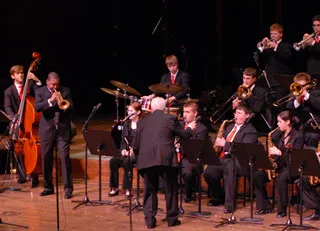EPISODE 3:
the basie feel

In this series of videos, Vic Firth Artist and Educator STEVE HOUGHTON will discuss rhythm section concepts within the big band setting. Designed for the jazz educator and student alike, Steve will cover many of the standard jazz styles (such as swing, shuffle, rock, ballads and Latin) and will detail the roles of each of the rhythm section players within those styles.
Throughout these videos, Steve – with the help of the Foxborough High School Jazz Ensemble – will demonstrate common problems that exist in the typical jazz ensemble setting and will show you real world solutions that can help your band vastly improve its sound, clarity and groove!
ESSENTIAL TOOLS FOR THE JAZZ DRUMMER
ABOUT THE PROJECT AND DEMONSTRATION ENSEMBLE:
During the 2011 Massachusetts Music Educators Association Conference, Steve Houghton was given the opportunity to work with one of the most successful jazz programs in the country: the Foxborough High School Jazz Ensemble, under the direction of Stephen C. Massey. Houghton was immediately impressed by the band’s ability to perform in all of the various styles, and particularly with the rhythm section players’ depth of understanding of each of their roles within the big band setting.
Through this successful clinic, geared towards solving common problems in the middle and high school jazz ensemble, a seed for bringing the information to a wider audience was formed. Rather than use professional musicians, Steve thought it best to show how fantastic a high school ensemble can sound if they understand the fundamentals of jazz – and this ensemble indeed had a firm grasp on all of the concepts that he wanted to demonstrate on video for vicfirth.com!


FUNDAMENTALS BEHIND A GREAT RHYTHM SECTION
Excerpted from “Rhythm Section Workshop for Jazz Directors” by Shelly Berg, Lou Fischer, Fred Hamilton and Steve Houghton / Published by Alfred Publishing Co. ©2005; Used with Permission
The rhythm section is the energy core of any jazz ensemble. From the rhythm section radiates the groove, time and spirituality of the music. It is the intensity of the rhythm section that “infects” the remainder of the ensemble, helping them to play with the style and intent of the music.
Unfortunately, much of the music we play in rhythm sections is either notated poorly or inadequately, or is deliberately sketchy to leave room for innovation. So, rhythm section players must learn to create grooves on their own, as opposed to what may be written!
GROOVE AND SUBDIVISION
Obviously, the rhythm section must provide a groove. Our definition of the verb groove is, to create constant energy channeled into subdivision. For every kind of beat (or feel), good rhythm sections understand the underlying subdivision and apply it to the type of energy that gives the music the appropriate “life.” We like to say that the answer to every question having to do with tempo, time, groove, counting, etc., can be answered with just one word, subdivision (or subdivide). How do we keep from rushing or dragging? Subdivide. How do we all play that note on the “and” of three together? Subdivide. How do we all play in the same groove? Subdivide.
The verb, to groove is not to be confused with the noun, groove, or the time feel. The purpose of this project is to help you teach students how to groove in the typical styles that most intermediate jazz ensembles play.
CLARITY AND DEFERENCE
Next to groove, clarity and deference are the two most important words for rhythm sections. Clarity is essential. Never tolerate a rhythm section that muddies the sound of the ensemble. Here are some factors that can affect clarity: playing at the wrong volume, playing too much, playing inappropriately,, playing too many sustained chords, playing with a poor sense of time and groove.
Deference implies that a player will yield (or defer) to someone else by leaving space in his or her own part. The space that one player leaves highlights the beautiful idea in someone else’s part. So you see, deference is a key element in achieving clarity.
TIME IS A WEIGHT
Although it is the rhythm section’s job to play with excellent time, it is not the rhythm section’s sole responsibility to do so. Think of time as a weight, perhaps a steel plate weighing 500lbs. If we lower that plate onto the ensemble, and ask everyone to raise their arms up to hold it, they will find the weight quite manageable. It seems to float in the air. But, if we instruct everyone except the drummer to let go, all will be crushed by the weight. The same is true with time. It floats in effortless fashion when each ensemble member holds up his or her little piece of
COMPING
Comping is the rhythmic accompaniment of chords played by piano and/or guitar. Some say that the word is derived from “accompany,” while others trace the derivation to “complimenting.” Perhaps both explanations are correct.
LISTEN!
Most societies pass grooves down from generation to generation in a great aural tradition. Western music seems to be learned more from process and explanation. This method is inadequate when applied to jazz grooves. The aural apprenticeship must be observed for jazz music to spring to life. Be sure to have your students listen to great recordings. Over time they will develop an intuition for groove and style. After all, as Duke Ellington said, “It Don’t Mean a Thing, if it Ain’t Got that Swing!”
STEVE HOUGHTON
Internationally renowned jazz drummer, percussionist, clinician, author, and educator, Steve Houghton initially received acclaim at age twenty as the drummer with Woody Herman’s Young Thundering Herd. Since then he has shared stage and studio with luminaries Freddie Hubbard, Rufus Reid, Gary Burton, Dave Stryker, Clay Jenkins, Shelly Berg, Jared Gold, Lyle Mays, Bob Sheppard, Billy Childs, Bobby Hutcherson, Pat LaBarbara, Bobby Shew, Wayne Bergeron, Bill Cunliffe, Arturo Sandoval, Steve Allee, Joe Henderson, Ray Brown, Karrin Allyson, Dianne Reeves, among others.
As a band leader Houghton’s discography includes: The AHA! Quintet – Freespace, The Manne We Love: Gershwin Revisited , a recent release of John Williams’ charts for big band and quintet, Live @ The Senator – Steve Houghton Quintet, Windsong, Remembrances, and Steve Houghton Signature. In total Houghton attributes more than one hundred recordings to his credit as a participating artist. As a classical percussionist, Houghton has performed with the Boston, and Philadelphia Pops orchestras, U.S. Army Band, as well as the Hollywood Bowl Orchestra. He frequently appears as a soloist with numerous orchestras and wind ensembles throughout the world.
As an author, Houghton’s publications boast more than thirty educational books, videos and DVDs including: Drumset 101, Kid’s Drumset Course– books 1 & 2, Essential Styles- books 1 & 2 , The Ultimate Drumset Chart Reading Anthology (Alfred), Play and Teach Percussion (GIA), and The Drumset Soloist (WB), and his latest project, Rhythm Section Workshop for Jazz Directors (Alfred) is a DVD-book series that addresses the entire rhythm section. He has recently created two new educational series for the Vic Firth website, entitled Rhythm Section 101, and The Jazz Trio – An Inside View.
Houghton presents yearly clinics and master classes to students around the world; most recently Germany, England, China, New Zealand, Australia and Taiwan. Houghton is a Past- President of the Percussive Arts Society (PAS) a founding member of the Jazz Education Network (JEN) and endorses, Zildjian cymbals, Vic Firth sticks and mallets, Yamaha drums and percussion and Remo world percussion products and drumheads.
Visit Steve online at http://www.houghtonmusic.com

PERFORMANCE WITHOUT LIMITATION…BY DESIGN
For nearly 60 years, we at the Vic Firth Company have focused on developing and manufacturing what has become the world’s most popular drumsticks, mallets, alternative implements, and accessories… with the best durability, feel, and sound options, across the widest variety of genres and styles.




